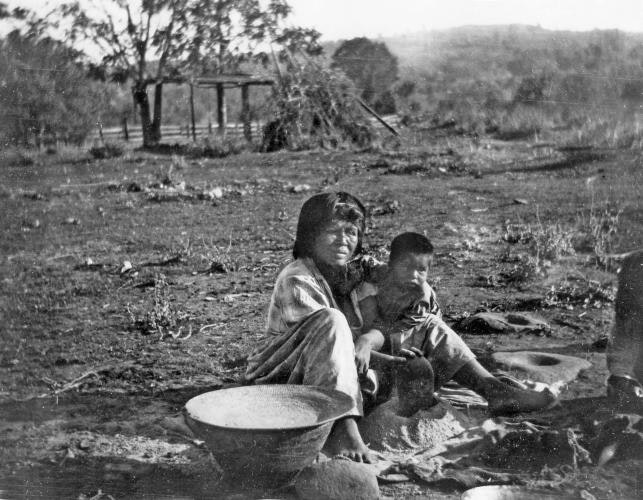Settlement and Subsistance

Regardless of when the Mi-Wuk arrived in central California, the first non-natives entering the area found a well-established society of hunters, fishermen, and plant-food gatherers whose territory stretched from the edge of the San Joaquin Valley to the high elevations of the Sierra Nevada. This wide topographic and vegetative range provided the native people with all manner of foods: antelope, elk, rabbit, salmon, waterfowl, and valley-oak acorns in the lowest zone; deer, rabbit, salmon, valley quail, gray pine nuts, and blue- and live-oak acorns in the foothills; and, at higher elevations, deer, squirrel, trout, mountain quail, pigeons, sugar-pine nuts, and black-oak acorns 1 (p.10). Acorns were particularly important and, according to Heizer and Elsasser, “the [ethnographic-period] Sierra Mi-Wuk carefully preserved the oak trees from which they annually gathered their staple food” 2(p.23).
In Calaveras County, the old Mi-Wuk villages that are known to anthropologists were clustered along the Mokelumne, Calaveras, and Stanislaus river drainages. Traditional Mi-Wuk houses reportedly were made of thatching, tule matting, or slabs of bark over a conical framework of poles 3 (p.408). In fine weather the people cooked and prepared food outdoors; in bad weather they used an interior hearth and oven. Some families also dug storage pits into the floors of their houses. Other important structures were the sweat lodge and the dance house, both of which are still in use today. Sweathouses are used mainly by men for health and purification, while the semi-subterranean dance houses were used as an assembly hall and for important ceremonies. Remains of some of these large structures have been found at archaeological sites in the central foothills.
The archaeological record also contains remnants of a rich material culture, with flaked stone hunting and butchering tools; plant-processing implements; cooking, eating, and storage vessels (including beautifully made stone bowls); and beads and ornaments made of shell, animal bone, and stone. No doubt there were a great many other items made of basketry, cordage, or wood which have not survived. Like other northern and central California groups, the Mi-Wuk made (and still make) excellent baskets, but as far as we know they did not traditionally make or use pottery. Small lumps and objects of baked clay have been found at several sites in the valley and lower foothills (e.g., 4), but no pots or dishes. The foothill groups did make vessels from soapstone, and many of these also have been found in archaeological deposits.
Stone sourcing studies from sites in Calaveras County and the Mokelumne and Stanislaus river drainages indicate that the Calaveras Mi-Wuk obtained nearly all of their obsidian toolstone from the Bodie Hills source, on the eastern side of the Sierra; also found in much smaller amounts are glass from Napa Valley and from Casa Diablo on the east side (5). While their obsidian had to be imported, the Mi-Wuk had access to many other toolstones in the geologically complex foothills, such as slate and basalt.
1.The Natural World of the California Indians, Heizer, Robert F.; Albert B. Elsasser, California Natural History Guides 46., (1980).
2.The Natural World of the California Indians, Heizer, Robert F.; Albert B. Elsasser, California Natural History Guides 46., (1980).
3.Eastern Miwok, Levy, R., California,, Number 8, p.398-413, (1978).
4.Cosumnes Brownware: A Pottery Type Centered on the Lower Cosumnes and Adjacent Sacramento Rivers in Central California, Johnson, Jerald J., Hunter-Gatherer Pottery from the Far West., Volume 23, Carson City, NV, p.145-158, (1990).
5.Framework for Archaeological Research and Management, National Forests of the North Central Sierra Nevada., Jackson, R.J.; T. jackson; C. Miksicek; K. Roper; D. Simons, Eldorado national Forest, Placerville, Ca, Sacramento, Ca, (1994).
